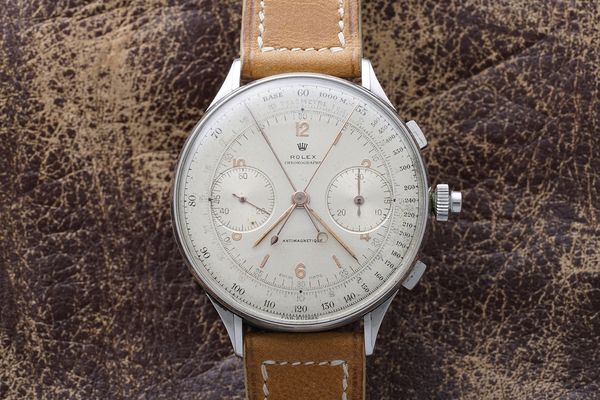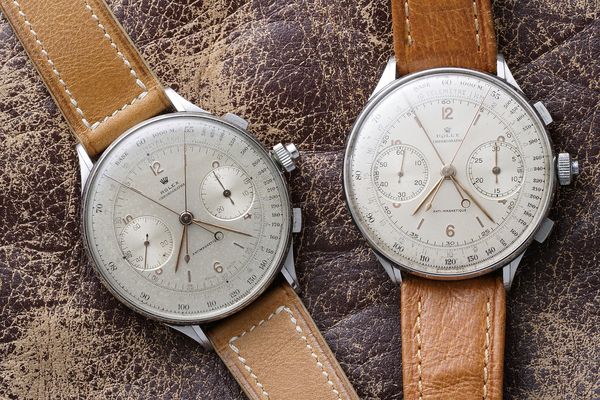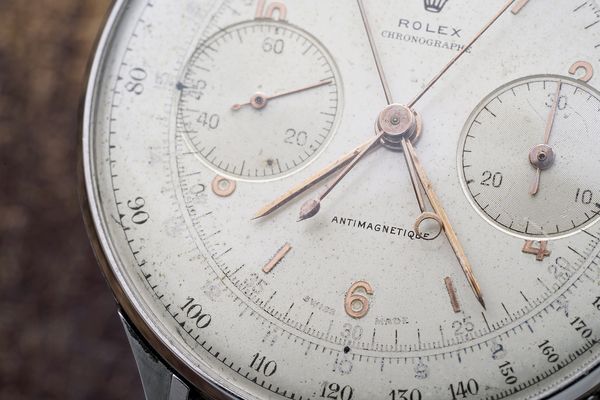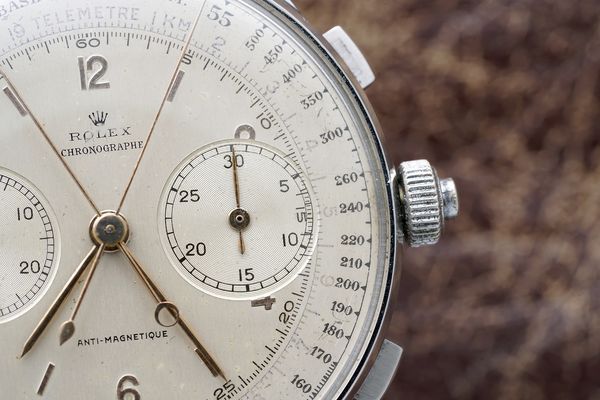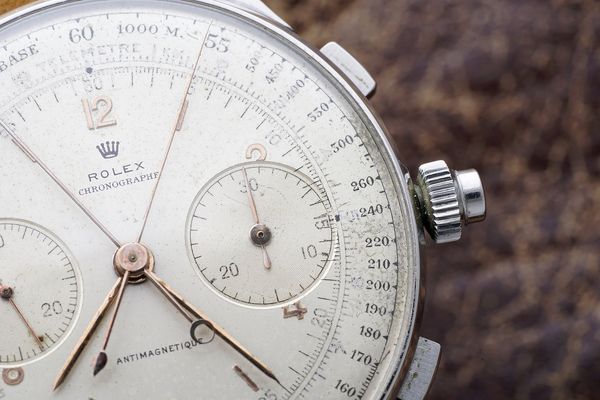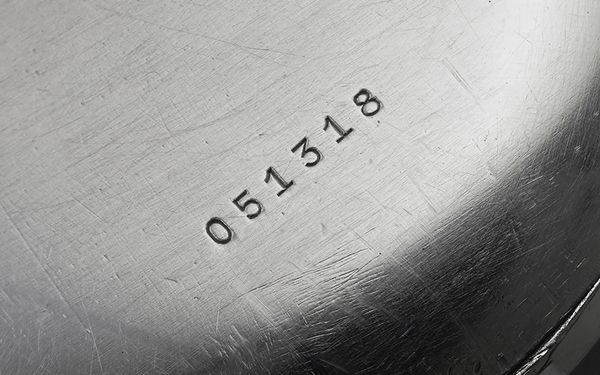- by Arthur Touchot
Pictured here is a historic meeting between two of only twelve split-seconds chronograph wristwatches ever made by Rolex.
The coming together happened during a surprise visit of Advisory Board member John Goldberger during the cataloguing of The Geneva Watch Auction X - more on who they are, and what they do for Phillips here. On his wrist that day, because he had chosen to wear it to the Goodwood Revival just 24 hours before coming to see us, was his trusty Rolex split-seconds Ref. 4113 – not a watch you ever expect to see on someone’s wrist, but the perfect companion piece to an afternoon at Goodwood, as Goldberger casually (and correctly) pointed out.
Little did he know we had another example in our offices that day, one of the remaining 11 made, and a then very recent consignment to The Geneva Watch Auction X (Lot 139). Let that sink in for a moment. Two of the twelve Rolex Ref 4113, together in the same room, more than 70 years after they were made. By pure coincidence. And just like that we were reminded how special it is to be working for the Phillips watches department.

John Goldberger, with two Rolex Ref. 4113 models.
Few watches deserve to be called mythical, but there are several reasons to confer this title to the Reference 4113: it is the only split-seconds chronograph wristwatch Rolex has ever made, and many believe it is the finest amongst its contemporaries due to its rarity and elusiveness, only twelve were produced – the whereabouts of nine are known, with three yet to be discovered pieces.
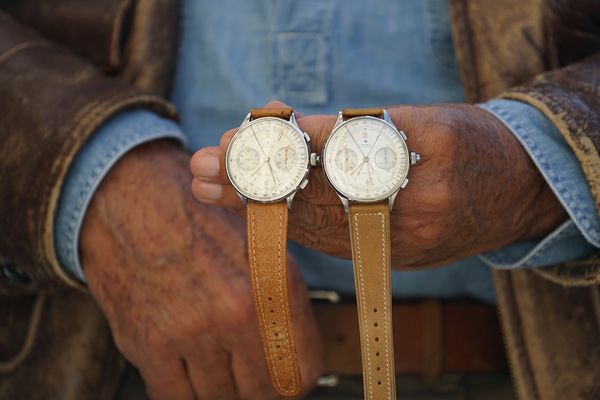
Goldberger's watch (left) and the one consigned to The Geneva Watch Auction X, Lot 139, (right)
For a while, very little was known about the Reference 4113 due to the fact that it has never officially appeared in Rolex catalogues, making it extremely difficult to research. However, a few examples have surfaced over the last two decades that have allowed experts to piece together this watch’s history – although the picture still feels incomplete.
Here’s what we know about the Reference 4113:
Scholarship tells us only twelve examples of reference 4113 were manufactured in the early 1940s and that all were encased in oversized, 44mm stainless steel cases numbered between 051’313 to 051’324.
Phillips has had the pleasure of offering one of these before, case number 051’314, during the START-STOP-RESET auction in May 2014. That example achieved CHF 2,405,000, setting a new world record for the reference - another reason for the reference’s mythical status – which it still holds to this day.
Lot 139 - The present model is the Ref. 4113 consigned to The Geneva Watch Auction X (case number 051’318)
Now, for a little piece of trivia:
Interestingly, that watch, as well as the other known examples were all formerly owned by families with strong ties to professional automobile racing, leading experts to believe the Reference 4113 could have been made for a group of racing teams and their drivers – either as a highly practical and then innovative piece of equipment for them to test cars speeds around the track – or perhaps even as prizes for winning races. Unfortunately, we can only speculate as to the meaning of this automotive connection and some of the watches’ features – namely the presence of a telemeter scale – raises more questions.
Another theme of the Reference 4113 is that each model seems to have a dial that is unique due to very subtle details, such as different intervals being used in the seconds and 30-min sub-counters, or the presence (and absence) of dots on the dial. Below is a comparison of the two watches that were in our office that day, Goldberger’s (number 051’321) and the one consigned to The Geneva Watch Auction X (number 051’318) to highlight some of these differences. Can you spot the seven major changes?
Playing The Game Of Spot The Difference With These Two Ref. 4113
Subregisters: All known Rolex Ref. 4113 models display two subdials, with seconds on the left, and a 30-minute counter on the right. However, there are subtle differences between in their size, and in the interval styles. In Goldberger’s, the seconds are displayed in 10 second increments, and the 30-mins counter into five minute increments. This is consistent with the record-setting Ref. 4113 wristwatch (number 051’314) sold in 2014. However, in the example offered in our upcoming Geneva Watch Auction X sale (number 051’318), the seconds are displayed in 20-second increments, and the 30-min counter in 10-minute increments.The size of the subregisters are also slightly different in both watches. In Goldberger's example, they are a little larger, as evidence by the cut of the Arabic numeras - see the applied 4 o'clock index.
Goldberger's watch (above) and Lot 139 of The Geneva Watch Auction X (below)
Swiss Made: Both watches bear a “Swiss Made” indication on their dial, but these are placed in different positions. On Goldberger’s Ref. 4113, the words “Swiss Made” can be found at the very bottom of the dial, at the edge of (and almost hidden by) the case. On our watch, these words appear on either side of the index that is applied at six o’clock. The bottom of the dial again mentions the watch’s country of origin, but this time in French. The mention of “Fab. Suisse” is generally reserved for watches destined for France.
Antimagnetic: The position and vocabulary used to mention the antimagnetic features of Goldberger’s and our Ref. 4113 are not consistent. In Goldberger’s watch, the word “Anti-Magnetique” is printed closer to the 6 o’clock index, with a hyphen between “Anti” and “Magnetique” whereas in our model, the word is contracted, without any hyphens, and is placed higher on the dial.
Goldberger's watch (above) and Lot 139 of The Geneva Watch Auction X (below)
Coronet and Rolex name: Both the coronet and the Rolex signature display differences in the two watches. They appear thinner in Goldberger’s watch and the typefont used includes Serifs, while the Rolex crown is bolder and the name is printed sans-serif in our example.
Telemeter Scales: Based on the examples known, we believe all telemeter scales were printed using light blue ink, but with time the colour has faded to different degrees therefore becoming a unique shade in every Ref. 4113.
Goldberger's watch (left) and Lot 139 of The Geneva Watch Auction X (right)
Presence of dots (or lack thereof) on the dial: Just like the Ref. 4113 case number 051’314 sold in 2014, the example offered in the Geneva Watch Auction X features four small black dots placed on the dial at 12, 3, 6, and 9 o’clock. This is in fact consistent with other vintage Rolex chronographs made during the early 1940s, as it was a way to quickly highlight the four most important quadrants of the dial. But these dots are not present on Goldberger’s watch.
Caseback serial number of Lot 139.
Case numbers: Finally, each Ref. 4113 is unique because of the case numbers found at the back of these watches. As mentioned earlier, we believe that twelve examples were made since the cases are numbered between 051’313 and 051’324. Golberger’s watch is number 051’321, while our watch is number 051’318.

